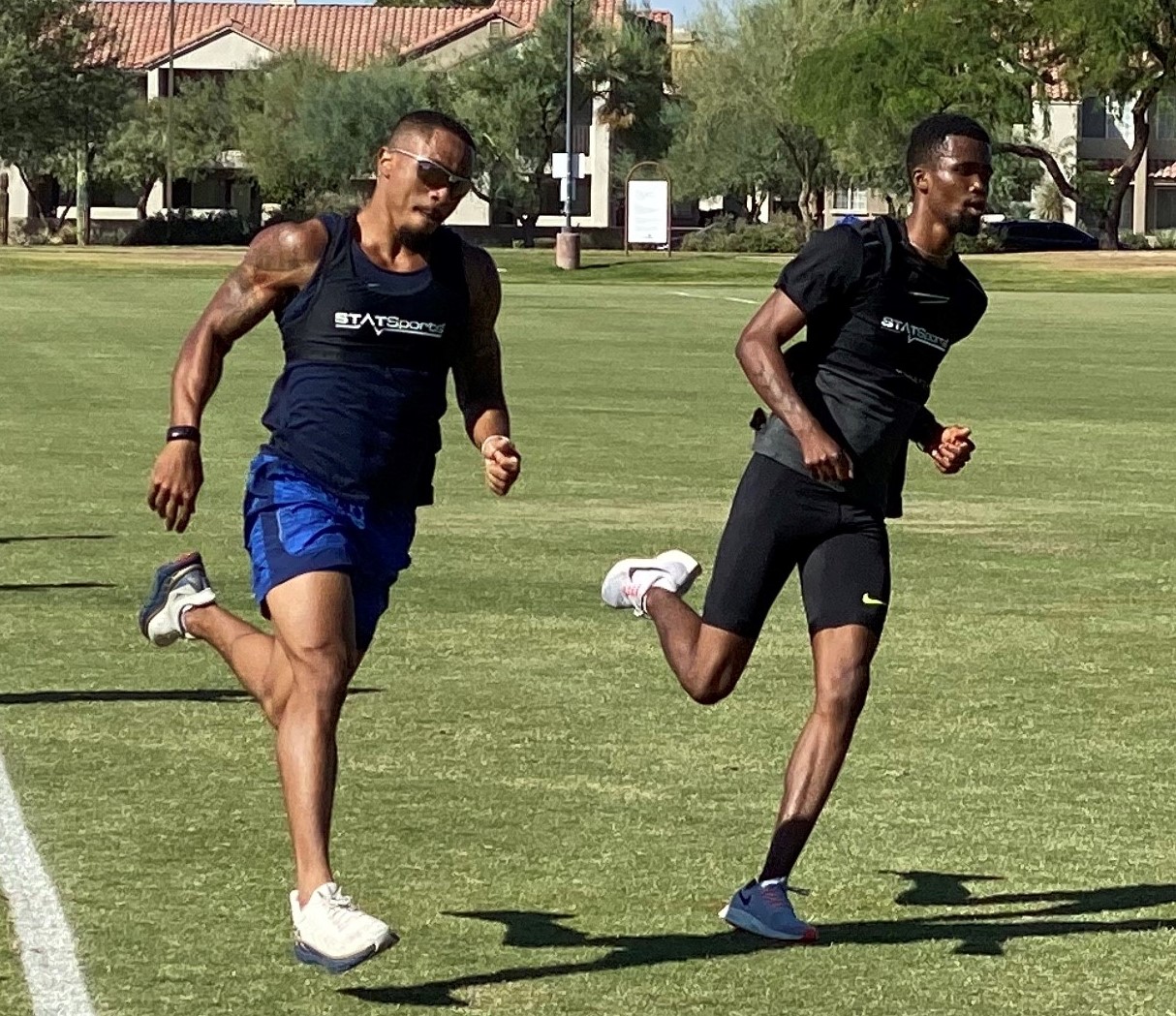
22 Dec Managing the Training Load in Track-and-Field Athletes
Introduction
Planning a training program represents one of the greatest challenges for those who work in Track and Field Sprint competition (De Weese et al., 2015). In fact, several aspects must coexist in it: long and short term development, loading and unloading phases, development of physical and technical skills and, of course, achieving the right form at the right competitive moment.
The knowledge about the effects of the development of the different performance qualities, their interconnection and their reciprocal interference is still in some ways unknown.
Because sprint running is a fundamental requirement for many sports, researchers have dedicated a huge amount of time to sprint training studies. However, the majority of the sprint-related studies have shown conflicting results, where most annual within-athlete performance changes could not be considered worthwhile (Haugen et al., 2018).
Both the area of the art of coaching and science need to contribute to the achievement of the goals that the athlete and trainer set themselves: the coaching area, which represents the intuition and creativity of the trainer to adapt with new strategies to the athlete’s changing situations; the scientific area, by making available all data collections and research on the ability of the human organism to adapt to a given training program.
Although in Athletics the majority of the elements of the training schedule are controlled, there is always some variability in the physical parameters that need to be objectively measured.
The aim of this insight is to provide recommendations for practitioners working in Track and Field regarding training load monitoring for sprint competition.
Practical Application
This insight presents the results of a week of pre-season preparation for an Italian Female National-level 400m Sprinter.
All training sessions examined were established by the head coach without any external advice. Data was collected from a GPS wearable worn by the athlete (APEX, 10Hz GNSS device).
Sprint events of 400-m fall within exercise durations that rely heavily upon both anaerobic and aerobic metabolism for energy production.
Despite near maximal or maximal utilisation of anaerobic glycolytic and phosphorylative pathways, a considerable amount of aerobic energy is also required to perform these type of high intensity efforts.
In order to effectively increase the endurance capacity, methods that are close to the corresponding metabolic requirements of the discipline should be applied and the physiological effects evaluated.
The international scientific literature suggests analysing the distribution of heart rate during the exercise (Hoff et al., 2002). In other words, the time spent by the athletes within the range defined as a percentage of the Max Heart Rate.
The data therefore refers to the percentage of the total time of the exercise, or of the training session, in which the subject remains in the area between 70-80%, 80-90% and above 90% of his heart rate max or other predetermined ranges.
The lower limit of this “useful band” is often referred to as the boundary zone for high intensity training within works published in the literature and as a threshold that allows to adequately stimulate aerobic qualities (Hoff et al., 2002).
As represented in Figure 1, we verified in our analysis the percentage and amount of time in which the athlete was within the range between 70-80%, 80-90% and above 90% of their maximum heart rate, in 3 different drills within the session.
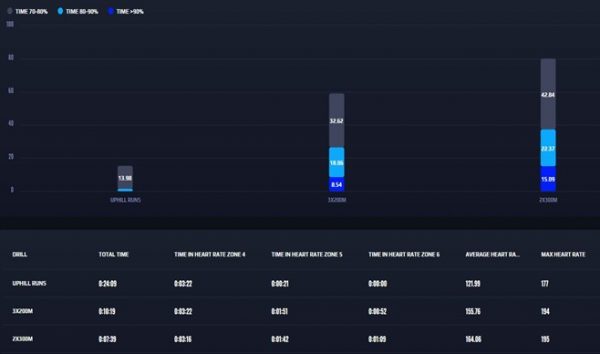
Fig.1– Combo Chart showing the Percentage of the Total Time (h:mm:ss) of the drills by the athlete in different Heart Rate Zones. In the metric table is shown the Time Spent between each heart rate zones (h:mm:ss), Average Heart Rate (bpm) and Max Heart Rate (bpm).
A further analysis that can be made with the Heart Rate data is the monitoring of the training status of the athlete through Heart Rate Recovery (HRR).
HRR can be assessed as the difference between the HR at cessation of exercise and the HR at the end of the recovery period (i.e. 60 s after). HRR has been shown to be a practical tool for monitoring the response to training and has been validated after a wide variety of exercise intensities (~60–100% of MAS) in trained athletes (Le Meur et al., 2017).
Improvements in HRR can be associated with improved fitness, while a slower rate of recovery may be indicative of increased fatigue (Buchheit et al., 2008).
Although fatigue is a normal and desired part of the training process, if unplanned fatigue persists for several weeks, the athlete might enter into a state of non-functional overreaching, which would be detrimental for the athlete.
HRR may be a practical tool to assess the fatigue state simply by reproducing a standardized submaximal test each week. Figure 2 provides an example of the heart rate response following 10 minutes submaximal steady state running at 12 km/h.
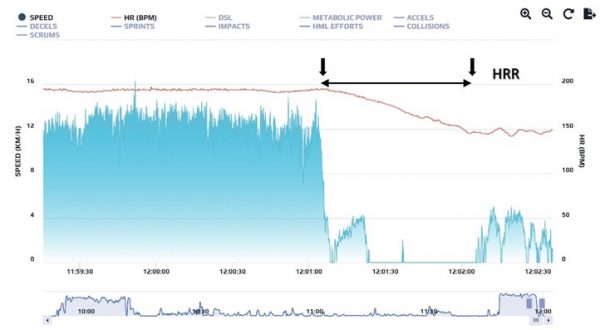
Fig 2. Heart rate response after 60 seconds of 10 min of sub-maximal steady state run at 12 km/h.
If we shift the attention to the external load of the athlete, we must progressively prescribe High-Speed training with a gradual loading occurring from week to week (Haugen et al., 2019).
If we assume that appropriate recovery times are observed, this will allow the athlete to adapt to a given stimulus and progressively strengthens the neuromuscular system.
Observing the distance covered above a certain threshold is an example of how training load can be tracked and utilized to improve training planning over the course of the training cycles.
Figure 3 displays the distance covered between 5.5 m/s and 7 m/s and above 7m/s in a typical pre-season week. An in-depth analysis of the load prescribed throughout the different training cycles is needed to understand the responses over the course of a training year.
A correct manipulation of the training volume, intensity and frequency will help the athlete to perform at their best during the competitive calendar.
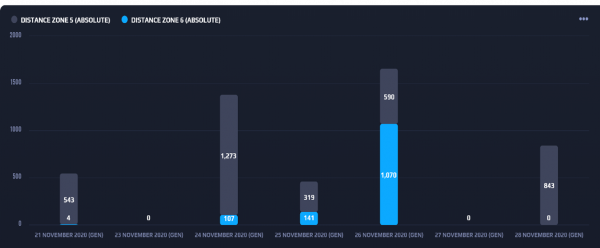
Fig 3. Combo chart showing the distance (m) between 5.5 -7m/s and above 7m/s during a typical pre-season week of an Italian Female National-level 400m Sprinter.
From an injury prevention standpoint, it is paramount for the coach to introduce sprinting in a gradual and progressive manner, moving towards peak speed in the final precompetitive phase, when the athlete will be able cope with the stress caused by high velocities of movement (Askling CM et al.,2007).
In fact, coaches and athletes should be aware that the muscular structure is under tremendous forces during sprinting and they must be careful of how quickly they reach max velocities.
In Figure 4 we can see an example of the Max Speed reached and the percentage relative to their Max Speed in a typical pre-season training week of an Italian Female National-Level 400m Sprinter; the combo chart shows that the athlete does not go above 83.7% of their reachable Max Speed throughout the week.
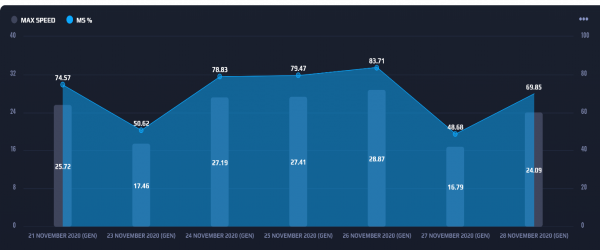
Fig 4. Max Speed (Km/h) and Percentage of Max Speed reached during the pre-season week of an Italian Female National-level 400m Sprinter.
Beyond the importance of quantifying the intensity of the exercise to which athletes have been exposed, it remains of fundamental importance to monitor the volume of work performed: Lehmann et al. (1993) suggests that this may be one of the critical elements in the onset of “under performance” syndromes.
The training load should therefore be inclusive of all the stimuli (internal and external load given by the sessions, load given by strength work, psychological load given by competitions, etc.) that the athlete receives during the season.
The control of the training load is only one of the elements to be monitored and the information deriving from training should be combined with those deriving from medical and performance tests.
Practical Considerations
The purpose of training load monitoring is to enhance decision making throughout the training process. In elite sprinting, where very small margins are meaningful, knowledge of the scientific evidence and an appropriate training plan can have a considerable impact on the performance of the athlete (Bourdon, 2017).
With top athletes, only through the full exploitation of their performance reserves is it possible to obtain the most optimal performance outcomes. The short, medium, and long-term planning of an athlete’s maximum individual performance can only be done on the basis of a precise and consistent analysis of the performance status.
In fact, the training process must not be understood as a rigid process with fixed and immutable stages, but as an organized and flexible process which considers the needs that are created over time and the continuous changes that the athlete faces. ” Theory without practice is empty; practice without theory is blind”.
Author Details
Alberto Silingardi
Sport Scientist
References
- Askling CM, Tengvar M, Saartok T, Thorstensson A. Acute first-time hamstring strains during high-speed running: a longitudinal study including clinical and magnetic resonance imaging findings. Am J Sports Med. 2007;35:197–206
- Bourdon PC, Cardinale M, Murray A, Gastin P, Kellmann M, Varley MC, Gabbett TJ, Coutts AJ, Burgess DJ, Gregson W, Cable NT. Monitoring Athlete Training Loads: Consensus Statement. Int J Sports Physiol Perform. 2017 Apr;12(Suppl 2):S2161-S2170. doi: 10.1123/IJSPP.2017-0208. PMID: 28463642.
- Buchheit M, Millet GP, Parisy A, Pourchez S, Laursen PB, Ahmaidi S(2008) Supramaximal training and post-exercise parasympathetic reactivation in adolescents. Med Sci Sports Exerc40:362–371
- DeWeese, B. H., Hornsby, G., Stone, M., & Stone, M. H. (2015). The training process: Planning for strength-power training in track and field. Part 2: Practical and applied aspects. Journal of Sport and Health Science, 4(4), 318–324. https://doi.org/10.1016/j.jshs.2015.07.002
- Haugen T, Seiler S, Sandbakk Ø, Tønnessen E. The Training and Development of Elite Sprint Performance: an Integration of Scientific and Best Practice Literature. Sports Med Open. 2019;5(1):44. Published 2019 Nov 21. doi:10.1186/s40798-019-0221-0
- Haugen T, Solberg PA, Morán-Navarro R, Breitschädel F, Hopkins W, Foster C. Peak age and performance progression in world-class track-and-field athletes. Int J Sports Physiol Perform. 2018;13(9):1122–9.
- Hoff J. et al. (2002). Br. J. Sports Med., 36 : 218 – 221
- Le Meur Y, Buchheit M, Aubry A, Coutts AJ, Hausswirth C. Assessing Overreaching With Heart-Rate Recovery: What Is the Minimal Exercise Intensity Required? Int J Sports Physiol Perform. 2017 Apr;12(4):569-573. doi: 10.1123/ijspp.2015-0675. Epub 2016 Sep 6. PMID: 27617566.
- Lehmann M, Foster C, Keul J. Overtraining in endurance athletes: a brief review. Med Sci Sports Exerc. 1993 Jul;25(7):854-62. doi: 10.1249/00005768-199307000-00015. PMID: 8350709.